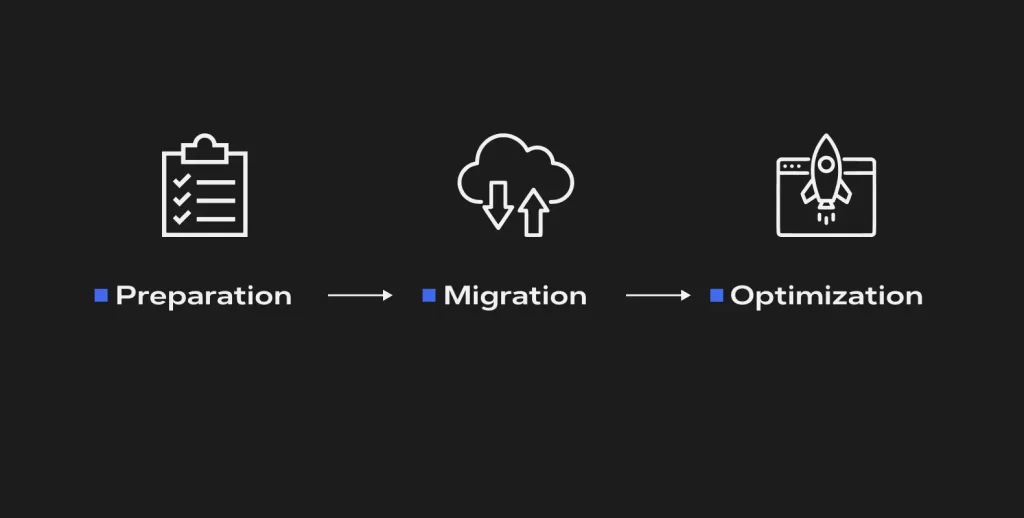We use cookies to ensure we give you the best experience on our website. By clicking Agree you accept our Privacy and Cookies Policy.
The process of application migration to the cloud: stages, approaches, and tools
Oleh Havrylyuk
Author

March 3, 2024
Date

 11 minutes read
11 minutes read
Content
Every year, more and more companies are migrating to the cloud. The reasons are obvious: it allows you to store large amounts of data without capital investment in infrastructure, access it anywhere in the world, and be confident in its security.
Since many businesses have already made the move to the cloud, migrations are currently happening very actively. Why is this tendency so common today? Let’s figure it out!
What is cloud migration?
Cloud migration is the process of transferring companies’ physical or virtual IT infrastructures to the operator’s cloud or to the facilities of a virtual data centre. Cloud migration often describes transitioning from an on-premises site to a cloud environment. However, migration can also be performed from one cloud to another: public, private, or hybrid.
As our experience shows, data migration to the cloud eliminates the need to purchase hardware, allows you to launch new projects quickly, and maintains your business process despite force majeure.
Why businesses migrate to cloud
Businesses are migrating to the cloud for several reasons. Firstly, it brings about lowered capital expenditures. What’s more, it usually results in increased efficiency and a reduction in downtime. If you haven’t considered migrating your business processes to the cloud, maybe it’s time you start looking towards it.
What you get from cloud migration
As a business owner, there are so many things to be benefitted from migrating to the cloud. Here what you can achieve with cloud migration:
Save time
Your company can save time in a few different ways by utilizing the cloud. Your team may now rapidly exchange docs when working on projects together and get feedback right away, stopping an email attachment cycle that never ends.
Additionally, you will get assistance for your use of the cloud and the migration if you are utilizing a support service. You may contact the service team at any time rather than waiting for the IT guy to arrive. In all, using the cloud reduces effort and saves time.
Scalability
The cloud liberates companies, allowing them to easily and quickly increase or decrease the amount of computing resources as needed. This is in stark contrast to on-premises infrastructure, which often necessitates the purchase and configuration of additional physical servers, network equipment, or software licences.
Cost
Companies that make the strategic move to the cloud can significantly reduce the cost of their IT operations. This is because the cloud is maintained and updated by the operator, freeing up valuable funds that can be reinvested to launch new products or solutions, and generally to develop the business.
Productivity
Moving to the cloud increases productivity and improves the end-user experience. Applications and programmes can be easily scaled to serve more users or increase bandwidth, and run in locations close to end users to reduce network latency.
Give your company a competitive edge
Making a switch to the cloud offers a quick and effective approach to increasing your competitiveness. Regardless of the size of your company, the cloud gives you access to enterprise-class solutions. This makes it possible for companies of all sizes to compete on an equal footing.
Improve data security
By using the cloud, you can prevent total data loss in the event that a company laptop is stolen or lost since your data is backed up there. Additionally, adopting the cloud minimizes the possibility of data loss or data corruption during server outages or load shedding.
With the cloud, there are several techniques to ensure the systems or data are only accessible to those who require them. Thus, you can be sure that your data is always secure.
Promote collaboration and remote work
Thanks to the cloud, employees can easily collaborate on documents, which they can share, view, and edit from any location at any time. Due to recent world events, many organizations were forced to adopt remote working, and online collaboration has since grown to play a significant role in many corporate strategies.
When you use the cloud, your staff do not necessarily have to be physically present to work together. They can collaborate effectively while working remotely from any location via an internet connection.
Increase flexibility
Businesses frequently experience varying bandwidth needs, and operating in the cloud lets you downscale or upscale your capacity. Because cloud capacity depends on remote servers and flexibility is a fundamental component of the service, scaling up or down is a lot simpler to accomplish.
Businesses that are highly agile are not constrained by IT. Hence, they have an edge over rivals since they can sell their products more quickly.
Safeguard your data in case of a disaster
Utilizing the cloud can assist your company by implementing a cost-efficient and effective disaster recovery plan. Systems and data can be readily transferred and safeguarded using tools and services provided by service providers in a way that best matches your company’s disaster recovery plans.
Examples include complete replication to other clouds (cold, hot, and warm standbys), multiple copies of cloud backups, and cross applications that are load balanced across different clouds.

Application migration steps
Once a database is chosen for cloud migration, the processes of planning, preparation, migration, and optimization can begin. Read about it in more detail below.
Preparation
The database cloud migration procedure starts with the planning phase. You determine the connections between your apps and databases during preparation. It’s also essential to plan your budget according to migration price evaluation that can be done with Azure calculator.
In order to identify the cloud migration categories—from straightforward rehosting (homogeneous migration) to re-architecting (heterogeneous migration)—you also have to assess the database workloads. Failing to complete this step can cause migration schedule delays.
Using the 7 Rs of migration (rehost, replatform, relocate, repurchase, refactor, retire, and retain) to organize the data you’ve gathered is another vital part of the cloud migration planning process.
Determine your migration to the cloud strategy based on your organization’s objectives for moving to the cloud, as well as any other relevant factors, such as timeline, budget, and resource availability.
Application migration to the cloud
The actual migration happens once you’ve finished your application migration to the cloud planning and decided on a migration strategy. This stage involves designing the target database, moving the source data there, and validating the newly transferred data.
This procedure consists of repeated conversion, migration, and testing phases. You can switch to the new database once the functional and performance testing is done.
The essential steps of the migration phase are listed below:
- The schema conversion process
- Data migration
- Application updating
- Migration testing
- Switching to the new database
Optimization
As soon as your application is on the cloud, you can begin improving it by utilizing several services that you can activate with just a few clicks. Optimize your application stack in a number of ways, including how it performs, how much it costs, how secure it is, and how well it can withstand failure. For instance, automatic scaling features can be used to minimize costs by adding additional read replicas during peak hours and removing them during off-peak hours. The benefits of hosting applications on the cloud can be used to their fullest extent during the optimization stage.
Application migration approach
As mentioned above, there are 7 possible approaches to application migration to the cloud. Here is a brief summary of them:
1. Rehost (lift and shift):
This method simply involves moving an application to the cloud. Relocate (hypervisor-level lift and shift): Transfer infrastructure to the cloud without investing in new hardware, updating your software, or changing the way things are currently done.
2. Replatform (lift and reshape):
Move an application to a cloud-based environment while introducing some level of optimization to benefit from cloud features.
3. Repurchase (drop and shop):
Switch to a new product, usually by changing a traditional application to a SaaS product, and move data from your on-premises application to the current product.
4. Refactor (re-architect):
Move an application and change its architecture by utilizing cloud-native features to the fullest extent possible in order to increase agility, performance, and scalability.
5. Retain (revisit):
Keep apps in their original environment. Examples of these could be legacy apps that you want to keep running because there isn’t an economic justification for moving them or applications that need significant reworking but you want to put off doing that work until later.
6. Retire:
Deactivate or delete programs from your source environment that is no longer required.


Considering moving your applications to the cloud?
Learn more about the process and how we can help you navigate a successful migration.
4 options for moving to Azure
As Blackthorn Vision has extensive experience working with Azure, let’s consider 4 alternate strategies for this service, including their pros and cons.
The most effective methods for moving an app to the Azure Cloud are as follows:
1) Lift-Shift Policy: Using this method, the settings of the underlying applications are not altered while they are transferred from the on-premise platform to the cloud. Teams with minimal cloud computing and Azure capabilities can use this tactic because it is appropriate for legacy migrations.
Pros: With less chance of application failure, this technique enables customers to migrate swiftly and painlessly.
Cons: The application might not take full advantage of cloud resources.
2) Subjective to Code Changes: This tactic merely modifies the application code, leaving out other crucial elements. By utilizing services like Azure App Service, Azure Functions, and Azure SQL Database Managed Containers, the user may reap the benefits of the both IaaS and PaaS. This is appropriate for businesses that are concerned about application scalability.
Pros: This is a speedy approach to upgrading your infrastructure.
Cons: Major infrastructural changes are not possible.
3) Architecture Revamp: This method entails modifying, optimizing, and deploying software to the Cloud platform (which requires high agility, scalability, and resilience).
Pros: Allows you to efficiently and cheaply meet scalability needs. Azure’s features can be used by new applications. increased agility
Cons: Migration is complicated, expensive, and there is a considerable danger of errors and service interruptions.
4) Restructure: This strategy entails rewriting apps from the ground up utilizing cloud-based tools like Azure PaaS. This enables the company to obtain whole development and deployment services. This tactic is appropriate when you have apps that are slowing down business processes due to their limited functionality and longevity.
Pros: There is no expensive or complicated software licensing, middleware, or resources to support.
Cons: Custom-made apps will have less functionality overall.
Our experience of successful cloud migration
Over the last 14 years, Blackthorn Vision helps business owners migrate their apps to the cloud with minimum disruption to operations. We provide a comprehensive range of services, from assessment and planning to implementation and testing, helping our clients move to the cloud quickly and safely. Our team of experienced cloud engineers are certified in Amazon Web Services (AWS) and Microsoft Azure, giving you the assurance that your migration is in the best hands.

One of our recent clients, unTill, provides business intelligence products for hospitality business. Our team modernized their legacy software into a cloud-based solution with comprehensive data management features and developed several mobile apps and API that extends POS functionality. Here are the main steps we took to modernize their legacy application:
- Since the existing architecture was outdated and didn’t suit cloud hosting requirements, we used architecture re-engineering approach. Our developers migrated to the cloud the original app from single-tenant to multi-tenant architecture, making the whole system more flexible and versatile. This allowed to monitor the app’s infrastructure and apply effective security measures.
- We also updated the code base to Angular and ASP.NET that let us redesign user flow and interface in line with client requirements.
- To ensure fast and smooth delivery, we implemented a CI/CD pipeline. The pipeline automated the process of building, testing, and deploying code to our production environment. This allowed us to quickly make changes and improvements, ensuring that stakeholders always receive the best version of the product.
- All the previous changes let us not only improve the app’s performance and usability, but integrate APIs and add new features, making it more competitive.
We are dedicated to providing a seamless cloud app migration experience. Our team of experts is available to answer any questions and guide you throughout the process. We strive to make your cloud migration as smooth as possible and to ensure that your applications remain secure, reliable, and cost-effective.
Contact us if you need assistance and expert advice in your cloud application migration journey.




































































